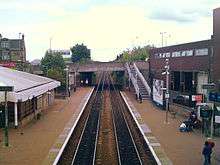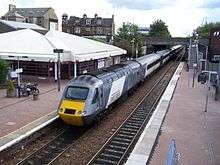Falkirk Grahamston railway station
| Falkirk Grahamston | |
|---|---|
|
The eastbound platform at Falkirk Grahamston railway station, looking westward | |
| Location | |
| Place | Falkirk |
| Local authority | Falkirk |
| Coordinates | 56°00′09″N 3°47′08″W / 56.0024°N 3.7856°WCoordinates: 56°00′09″N 3°47′08″W / 56.0024°N 3.7856°W |
| Grid reference | NS887802 |
| Operations | |
| Station code | FKG |
| Managed by | Abellio ScotRail |
| Number of platforms | 2 |
|
Live arrivals/departures, station information and onward connections from National Rail Enquiries | |
| Annual rail passenger usage* | |
| 2010/11 |
|
| – Interchange |
|
| 2011/12 |
|
| – Interchange |
|
| 2012/13 |
|
| – Interchange |
|
| 2013/14 |
|
| – Interchange |
|
| 2014/15 |
|
| – Interchange |
|
| History | |
| Original company | Stirlingshire Midland Junction Railway |
| Pre-grouping | North British Railway |
| Post-grouping | LNER |
| 1 October 1850 | Opened as Grahamston (Falkirk)[1] |
| 1 February 1903 | Renamed as Falkirk Grahamston[1][2] |
| National Rail – UK railway stations | |
| * Annual estimated passenger usage based on sales of tickets in stated financial year(s) which end or originate at Falkirk Grahamston from Office of Rail and Road statistics. Methodology may vary year on year. | |
|
| |

Falkirk Grahamston railway station is one of two railway stations serving the town of Falkirk in Scotland. It is located on the Edinburgh to Dunblane Line. Cumbernauld Line trains also terminate here. Train services are provided by Abellio ScotRail. The "Highland Chieftain", the daily Virgin Trains East Coast service from London King's Cross to Inverness and vice versa also calls here.
Falkirk is also served by the railway station at Falkirk High.

History
The line between Polmont and Larbert was built by the "Stirlingshire Midland Junction Railway", which was absorbed by the Edinburgh and Glasgow Railway prior to opening.[3] The line opened on 1 October 1850, as did the station known as Grahamston (Falkirk).[1][3] The subsequent addition of a chord line at Carmuirs to create a triangular junction there also gave access to the Scottish Central Railway and hence the E&G main line at Greenhill, creating a parallel relief route to the busy E&G line that was often used by local stopping trains between the two cities.
It also became the junction for the Grangemouth Railway, when the branch to the port of the same name on the Firth of Forth was opened in 1860/61 – this line was notable in that it was promoted and built by the Forth and Clyde Canal Company rather than any of the local railways, in order to maintain the F&CC's monopoly of the harbour there. The branch was initially worked by the E&G, but when the canal company was subsequently bought out by the Caledonian Railway, it passed into their hands; thereafter the E&G's successor the North British Railway had running powers over it. Passenger services there were withdrawn on 29 January 1968 as a result of the Beeching Axe, but the branch is still open for freight to the port and associated oil refinery & petrochemical plant.[4]
The station was renamed Falkirk Grahamston on 1 February 1903.[2] The original station buildings were replaced by the present ones in 1985/6.[5]
Services
Monday to Saturday there is a half-hourly service to Edinburgh Waverley eastbound and to Dunblane via Stirling westbound; also there is one per hour to & from Glasgow Queen Street via Cumbernauld. There is also a single weekday morning peak direct service to Glasgow via Lenzie which originates at Kirkcaldy; this returns there in the evening.[6] Glasgow services were diverted via Cumbernauld (rather than their former routing via Croy) in September 1999[7] in order to free up paths on the busy E&G main line.
On Sundays there is an hourly service to Edinburgh and Dunblane but no service to Glasgow. Passengers wishing to travel there have to either change at Polmont or use Falkirk High.
| Preceding station | |
Following station | ||
|---|---|---|---|---|
| Haymarket | Virgin Trains East Coast East Coast Main Line |
Stirling | ||
| Polmont | Abellio ScotRail Edinburgh–Dunblane Line |
Camelon | ||
| Stirling | Caledonian Sleeper Highland Caledonian Sleeper (southbound only) |
Edinburgh | ||
| Camelon | Abellio ScotRail Cumbernauld Line |
Terminus | ||
| Historical railways | ||||
| Camelon | Stirlingshire Midland Junction Railway North British Railway |
Polmont | ||
| Terminus | Grangemouth Railway Caledonian Railway |
Grangemouth | ||
Future Improvements
The line through the station and onwards to Larbert/Cumbernauld and to Polmont is due to be electrified by 2018 as part of the second phase of the Edinburgh to Glasgow Improvement Programme funded by Transport Scotland. This will also result in a timetable recast, with a new Glasgow to Edinburgh via Cumbernauld & Falkirk Grahamston stopping service introduced and services to Stirling & Dunblane accelerated.[8]
References
Notes
- 1 2 3 Butt (1995) page 107
- 1 2 Butt (1995) page 94
- 1 2 Awdry (1990) page 164
- ↑ Railscot - Grangemouth Railway, Railscot; Retrieved 2014-01-28
- ↑ Railscot - Falkirk Grahamston Crawford, Ewen, www.railbrit.co.uk; Retrieved 2014-01-28
- ↑ GB National Rail Timetable 2016, Table 230 (Network Rail)
- ↑ UK NRT Autumn 1999 Edition, Table 230
- ↑ "ScotRail announces major increase in daily trains" Dalton, A';Edinburgh Evening News article 15 March 2016; Retrieved 18 August 2016
Sources
- Awdry, Christopher (1990). Encyclopaedia of British Railway Companies. Sparkford: Patrick Stephens Ltd. ISBN 1-8526-0049-7. OCLC 19514063.
- Butt, R. V. J. (1995). The Directory of Railway Stations: details every public and private passenger station, halt, platform and stopping place, past and present (1st ed.). Sparkford: Patrick Stephens Ltd. ISBN 1-8526-0508-1. OCLC 60251199.
- Jowett, Alan (March 1989). Jowett's Railway Atlas of Great Britain and Ireland: From Pre-Grouping to the Present Day (1st ed.). Sparkford: Patrick Stephens Ltd. ISBN 1-8526-0086-1. OCLC 22311137.
- "RAILSCOT on Grangemouth Railway". Retrieved 29 September 2011.
